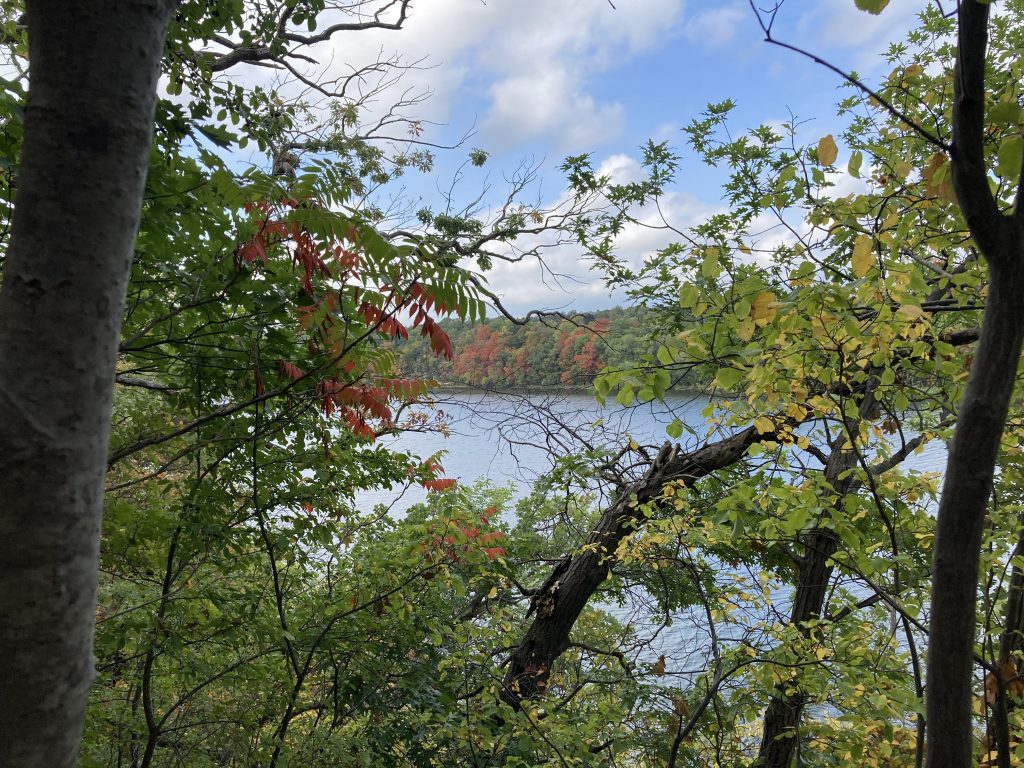4 miles
east river road and back*
65 degrees
humidity: 80% / dew point: 60
*over the lake street bridge/up the east river road, past The Monument/stopped at an unofficial overlook with a dirt trail leading closer to the edge/took a quick picture/turned around and ran back the same way

Another stretch of hot, sticky mornings. (There’s a heat advisory for the Twin Cities Marathon, which is happening on Sunday!) It felt warm enough that I wore the same thing that I do on the hottest summer day: black shorts and an orange tank top. I’m ready for this warmer weather to be over.
For the first half of the run, I listened to construction trucks, zooming cars, crunching leaves, my feet striking the asphalt, trickling water. For the second half, I put in my headphones and listened to The Wiz.
Yesterday and today I’ve been thinking about smell and trying to practice noticing smells. It’s hard! I thought I noticed more, but when I tried to dictate them into my phone, I could only remember 4.
smells: 4 noticed, 1 not
- a small patch of wet, muddy dirt in a neighbor’s boulevard: moist and earthy, a trace
- fallen, brittle leaves on the edge of the river bluff on the east side: dry, musty, sweet not tangy or sour
- the sewer near the ravine: rotten, subtle
- tar being used on a road: bitter, faint
- tried to smell a tree — I leaned in and inhaled deeply: nothing
My attempt at smelling the tree was inspired by this suggestion, from The Aroma of Trees:
Rest your hands on bark, feel its texture, then draw your face close. Gently rub. What aromas linger in the crevices of the tree’s surface?
It’s quite possible that I didn’t smell anything because I didn’t fully commit to this exercise. I leaned in quickly, right before heading off to run some more.
cold update: almost normal. For years now, my resting heart rate is between 50-55. Two days ago, when I felt especially crappy, it was 73. Today it’s back to 52. I’ve entered the most irritating phase: blowing my nose and trying to clear my throat all the time.
Read this about smell the other day:
When you see, hear, touch, or taste something, that sensory information first heads to the thalamus, which acts as your brain’s relay station. The thalamus then sends that information to the relevant brain areas, including the hippocampus, which is responsible for memory, and the amygdala, which does the emotional processing.
But with smells, it’s different. Scents bypass the thalamus and go straight to the brain’s smell center, known as the olfactory bulb. The olfactory bulb is directly connected to the amygdala and hippocampus, which might explain why the smell of something can so immediately trigger a detailed memory or even intense emotion.
Why Smells Trigger Such Vivid Memories
Also read this about why leaves smell and the effects of changes in temperature and climate change:
“That’s what fall is all about. Leaves are falling off the trees and the bacteria and fungi that are in the soil are actively digesting [them,]” said Theresa Crimmins, director of the USA National Phenology Network. “And in the process, various [gases] are being released, and that’s a lot of what the smells are.”
—
The heat and humidity of summer air traps all kinds of smells, she said, creating a “mishmash” for our noses.
But as the days get cooler and crisper, there are fewer volatile organic compounds in the air, and we’re better able to distinguish the ones that are released by dying and decomposing vegetation, leaving that sweet smell front and center.
The Science Behind the Aroma of Fall
Because of drought and warmer temperatures, fall is starting later, which is damaging to the long term health of trees — and might lead to less fiery leaf shows for us. I’ve been tracking the changing leaves by the Gorge since 2018, and so far, when I compare my descriptions of the leaves in the fall between 2018 and 2023, I’m not noticing huge changes. Acorns start falling in late July or early August. The first yellow or red leaves appear in late August. Full color is in early to mid October. But, how long will this last? And how quickly will it change?